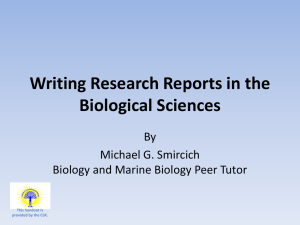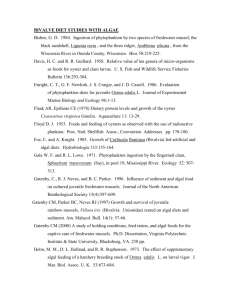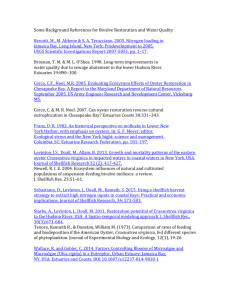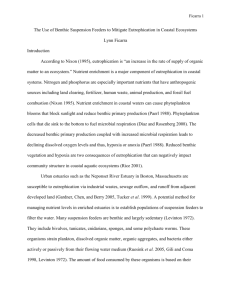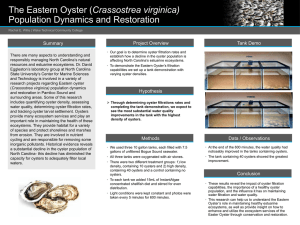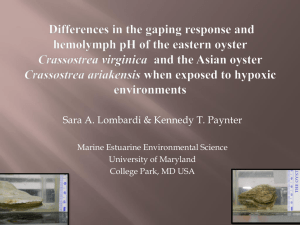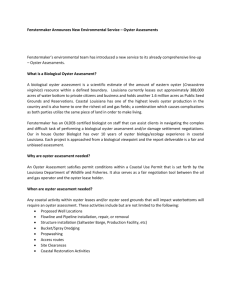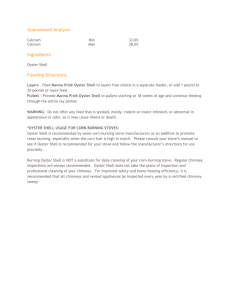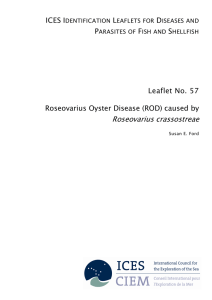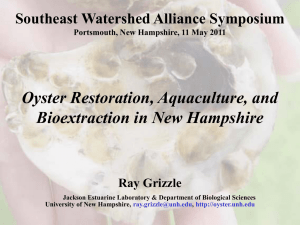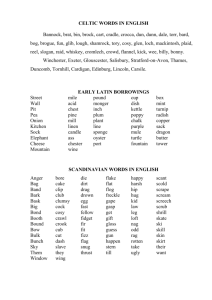Ficarra Filter Feeder - BIOEEOS660-f12
advertisement
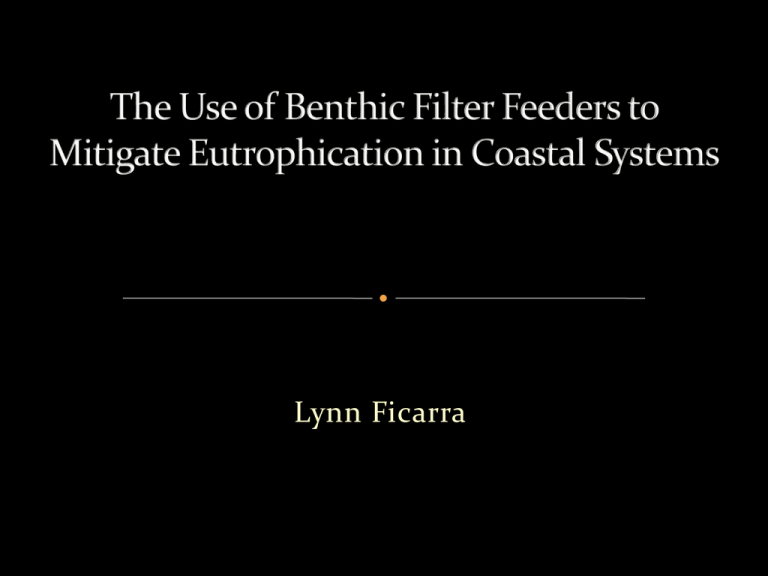
Lynn Ficarra “an increase in the rate of supply of organic matter to an ecosystem.” (Nixon 1995) N&P land clearing, sewage, fertilizer, animals, fossil fuels, industry Phytoplankton (Paerl 1988, Diaz and Rosenberg 2008) Block sun Die, sink to bottom, microbial respiration, hypoxia Remove phytoplankton, nutrients, organic materials, bacteria, and much much more! (Ruesink et al. 2005, Gili and Coma 1998, Levinton 1972). Filtration rate Depends on species, size, water velocity, temperature Efficiency of particle retention Depends on filtering structure (Comeau et al. 2008, Rice 2001, Eastern Oyster Biological Review Team 2007) Gills (Riisgard 1988) Parallel filaments Ciliary tracts: create current, capture particles Particles sorted (Newell 2004) Rejected: pseudofeces Digested: feces Mucus-coated aggregates Released to benthos Filtration Rate (Rank) Retention of Particles >4-5µm Retention of 2µm Particles Crassostrea virginica (Eastern oyster) 1 100% 50% Geukensia demissa (Ribbed mussel) 2 100% 35-75% Argopecten irradians (Bay scallop) 2 100% 15% Brachiodontes exustus (Scorched mussel) 3 100% 35-75% Spisula solidissima (Atlantic surfclam) 3 100% 35-75% Mercenaria mercenaria (Northern Quahog) 4 100% 35-75% Riisgard 1988 Capture Rate (mgC m-2d-1) Aulacomya ater (mussel) 1787 Chlamys islandica (scallop) 3621 Crassostrea virginica (oyster) 573 Geukensia demissa (mussel) 30 Mercenaria mercenaria (quahog) 351 Ostrea edulis (oyster) 9-30 Gili and Coma 1998 Mussels and eastern oysters performed well in both studies Crassostrea virginicus and Mytilus edulis Native to east coast of U.S. Atlantic coast of U.S. 0.6-5 m depth 20-30°C optimal Survive freezing and >45°C, feeding rate affected Survive at salinities of 5-40 ppt Filtration rate up to 30-40 L h-1 Create oyster reefs Promotes biodiversity Substrate for more suspension feeders (Ruesink 2005, MacKenzie 1996, Stanley and Sellars 1986, Galtsoff 1964, Shumway 1996, Eastern Oyster Biological Review Team 2007, Pechenik 2005) Coast of Canada to North Carolina 1-10 m depth 5-20°C optimal Survive freezing and up to 29°C >18 ppt ideal Survive low salinities 4-18 ppt, growth slowed Filtration rate 1.34-2.59 L h-1 Mussel beds Increases biodiversity Substrate for more filter feeders (Zagata et al. 2008, Goulletquer 2012, Bayne and Widdows 1978) Filtration rates at 9°C (Comeau et al. 2008) M. edulis: 1.82-2.90 L h-1 C. virginica: 0.05-1.21 L h-1 Optimal conditions: C. virginica faster than M. edulis Cold conditions: M. edulis faster Use both for eutrophication control Average filtering rate at optimal conditions for 44 filter feeding species is 7.8 L g-1h-1 dry weight (Pomeroy, D’Elia, and Schaffner 2006) Sponges (Milanese et al. 2003) retain up to 80% suspended particles Capture small particles that others miss (bacteria) Liverpool (Allen and Hawkins 1993) Mussels introduced to eutrophic water surrounding docks Two years later water quality and oxygen levels in water column and sediments improved Chesapeake Bay (Newell 1988) Pre-1870: oysters filter bay in 3-6 days Now: 325 days Competitive exclusion (Ruesink 2005) Toxic shellfish (MacKenzie et al. 2004) Invasive species (Ruesink 2005) Hitchhikers Pathogens (Moss et al. 2007) Asian oyster, Chesapeake Bay 2 protist parasites not found in U.S. waters Viruses, cestodes, other protist parasites Refer to Accompanying Paper
